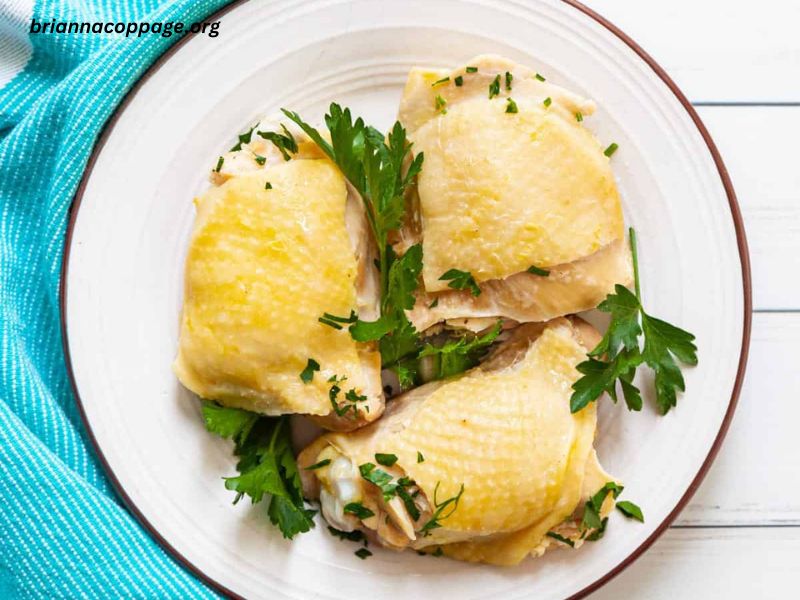Have you ever stood by the stove, wondering how long those chicken legs need to boil for perfection? Whether you’re making a cozy chicken soup, prepping meat for shredding, or aiming for flavorful, tender chicken legs, knowing the right boiling time makes all the difference. Boiled chicken is versatile, easy to make, and boasts a ton of health benefits—perfect for home cooks, health enthusiasts, and food bloggers alike!
This guide will walk you through the ideal boiling times for chicken legs, pro tips for locking in flavor, and delicious recipe ideas to inspire your next kitchen creation. Let’s get boiling!
Why Boiling Chicken Legs Is Worth It
Boiling might seem like the simplest cooking method, but don’t underestimate its power. This cooking process is the foundation for countless recipes, from hearty chicken noodle soup to spicy shredded chicken tacos.
Here’s why boiling chicken legs is a game-changer for home cooks and health-conscious individuals alike:
- Tender Meat: Boiling ensures your chicken legs are cooked evenly and become melt-in-your-mouth tender.
- Healthy Cooking Option: It’s low-fat and doesn’t require oil, making it ideal for calorie-conscious diets.
- Easy to Prep for Recipes: Boiled chicken is versatile, perfect for salads, casseroles, broths, and more.
- Saves Time: It requires minimal effort, so you can multitask while the chicken boils.
Now, before you fire up your stove, how long does it actually take to boil chicken legs?
How Long Should You Boil Chicken Legs?
The boiling time for chicken legs varies depending on whether they’re fresh or frozen, bone-in or boneless. Below is a handy guide to timing it perfectly every time.
Fresh Chicken Legs
- Bone-In: 20–25 minutes
- Boneless: 15–20 minutes
Frozen Chicken Legs
- Bone-In: 30–35 minutes
- Boneless: 25–30 minutes
To ensure your chicken legs are fully cooked, use a meat thermometer to check the internal temperature. The USDA recommends chicken be cooked to a safe internal temperature of 165°F (74°C). Simply insert the thermometer into the thickest part of the chicken (avoiding the bone) for an accurate reading.
Pro Tip: Bring your pot of water to a rolling boil, then reduce to a gentle simmer for even cooking and perfectly tender meat.
Steps for Perfectly Boiled Chicken Legs
Follow this foolproof technique to ensure deliciously moist and flavorful chicken every time.
1. Prepare Your Chicken Legs
Rinse the chicken legs under cold water and pat them dry with paper towels. Trim off any excess fat or skin if desired.
2. Season the Water
Fill a large pot with enough water to fully cover the chicken legs. Add seasonings like salt, pepper, garlic, bay leaves, onions, and any other spices or herbs you prefer. Want a richer flavor? Use chicken broth instead of water!
3. Boil the Water
Bring your pot to a rolling boil over medium-high heat. Once boiling, gently lower the chicken legs into the water.
4. Simmer and Watch the Clock
Reduce the heat to medium or medium-low to maintain a gentle simmer. Follow the boiling times provided above based on the type of chicken legs you’re cooking.
5. Check for Doneness
When the timer’s up, remove a chicken leg and cut into the thickest part to check for opaque, white meat and clear juices. Or better yet, use a meat thermometer for accuracy.
6. Rest the Chicken
Remove the chicken legs from the pot and allow them to rest for about 5 minutes. Resting helps seal in the juices, making your chicken even more tender and flavorful.
And just like that, you’ve got perfectly boiled chicken legs ready to enjoy!
Flavorful Additions for Boiling
While salt and pepper are classics, it doesn’t mean you have to stop there. Enhance the flavor of your chicken legs with these creative seasoning combinations:
- For Hearty Dishes: Bay leaves, thyme, rosemary, garlic cloves, and onion slices.
- For a Bold Kick: Chili flakes, smoked paprika, cumin, and cayenne pepper.
- For Asian-Inspired Flavors: Ginger, soy sauce, star anise, and green onions.
- For a Zesty Twist: Lemon slices, fresh dill, parsley, and a splash of white wine.
Experiment with different herbs, spices, and broths to create your signature flavor.
Creative Ways to Use Boiled Chicken Legs
Boiled chicken legs can form the base of so many delicious dishes. Here are a few ideas to spark inspiration in your kitchen!
1. Shredded Chicken Tacos
After boiling, shred the chicken and mix it with taco seasoning. Serve with tortillas, avocado, and fresh salsa for an easy, flavorful meal.
2. Chicken Caesar Salad
Chop the chicken into bite-sized pieces and toss it into a crispy Caesar salad with romaine, croutons, and Parmesan.
3. Classic Chicken Noodle Soup
Remove the meat and use the leftover boiling liquid as a rich base for homemade chicken noodle soup.
4. Chicken Stir-Fry
Slice the chicken and toss it into a hot skillet with your favorite stir-fry veggies and sauce.
5. Meal-Prep Bowls
Pair boiled chicken legs with roasted veggies and quinoa for a week’s worth of healthy, balanced meals.
With boiled chicken legs as your starting point, the possibilities are endless!
Pro Tips to Elevate Your Boiled Chicken
Here are some bonus tricks to help you master the art of boiled chicken legs:
- Double Duty Cooking: Boil extra chicken legs and store the meat in the fridge or freezer for quick meals throughout the week.
- Make It Broth: Don’t toss the leftover boiling liquid—it’s now a flavorful chicken broth! Strain it, store it, and use it in soups, sauces, and stews.
- Experiment with Marinades Post-Boil: Lightly season your chicken before boiling, and marinate it afterward for even more flavor.
By following these tips, you’ll turn a simple pot of boiling water into the foundation of numerous mouthwatering meals.
Making Your Kitchen the Heart of Flavor
Whether you’re a home cook trying to simplify weeknight dinners or a food blogger looking for reliable techniques, knowing how to boil chicken legs is an essential skill. It’s easy, healthy, and versatile—perfect for meal preps, creative recipes, or simply enjoying as is.
Now that you’ve unlocked the secrets to perfect boiled chicken legs, the next level of flavor awaits! Try experimenting with seasonings, recipes, and marinades to make this classic dish your own.






